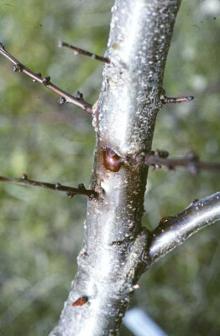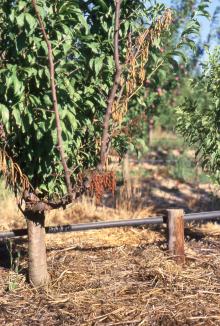See:
Cherry (Prunus spp.) - Bacterial Canker
Cause Pseudomonas syringae pv. syringae, a bacterium. Although the bacteria survive on the outside of the plant they must get inside and multiply in the space between plant cells (apoplast) to cause disease. These pathogenic bacteria inject several proteins and small-molecule toxins to get past host immune mechanisms. Once inside, the bacteria induce a watery, nutrient rich environment between the plant cells where they can multiply and continue colonization of the plant tissues. Bacteria also produce a protein that acts as an ice nucleus, increasing frost wounds that bacteria easily colonize and expand. Factors that weaken or injure the tree predispose it to developing cankers. Factors include wounds, frost damage, early pruning, soil pH, poor nutrition, and infection by other pathogens including Verticillium, Nectria, and nematodes. Sources of bacteria include old cankers, healthy buds, systemically within trees (with or without cankers), as epiphytes on leaf surfaces, weeds, grasses, and even soil. Wind, rain, insects, infected bud wood, and infected nursery stock can spread bacteria.
'Italian Prune' trees on peach seedling rootstock had half as many trunk cankers as trees on plum rootstocks. Pseudomonas infection was very severe on trees with Prunus tomentosa rootstock. French prune trees have been shown to be less susceptible on Lovell peach rootstock. Field-budded rootstocks or budding 3 feet above the root crown also helped reduce the incidence of bacterial canker on French prunes.
Symptoms The most conspicuous symptoms are cankers, gum exudation, and dieback of girdled branches. Dead buds and leaf spots also can occur. In most cases, heavy gumming is associated with bacterial canker formation on branches and twigs. Gumming occurs at the cankers' margins. Other problems can lead to gumming {see Cherry (Prunus spp. - Gumming)}.
Cankers caused by the bacteria may be on the trunk, limbs, and twigs. Typical cankers are much longer than broad, but a canker may girdle the infected limb or trunk. The cambium at the canker will be discolored and necrotic. Use a pocket knife to reveal this discolored tissue. Cankers develop in winter and early spring. As the tree begins growth in spring, the bacteria population declines and a callus layer forms around the canker's edge. During spring and summer, girdled and nearly girdled limbs may leaf out. Normally, leaves turn yellow, then the limbs usually die. In some instances, these symptoms may not appear until late summer when the leaves' water requirement is high.
Dead bud "disease" is first noted as dying buds on spurs in spring. Infected buds usually start to die in February. As the disease progresses, both leaf and flower become infected. Dead bud usually starts in lower limbs and moves up the tree and to adjacent trees in successive years. Often, trees in the lower orchard, where air drainage is poor, are the first to be infected. If all buds on a spur are killed, the spur will die back next season. Cankers very seldom form, but the diseased buds may produce a slight gumming. Repeated death of buds may result in misshaped growth and sometimes fasciation. In severe cases, 90% or more of buds on a tree may be killed.
Leaf and fruit spots are not common and are not numerous if they develop. Spots on leaves are at first water soaked, then become dry and brown. Spots on fruit are dark to black and depressed or pitted.
Cultural control Bacterial canker is best managed through the use of many different tactics.
- Plant resistant cultivars and/or rootstocks.
- Do not interplant new trees with old trees, which are a major source of the bacteria.
- Locate orchard in an area less likely to be affected by frost. If planting in the spring, plant orchards after date that frost is likely to have occurred. Prevent winter injury by painting trunks white and avoiding late season fertility.
- Test soil for ring nematodes before planting. Also test for pH and other physical characteristics that can be corrected prior to planting.
- Provide optimal soil conditions including attention to pH and nutrition. Annually monitor for adequate nutrient levels such as nitrogen. Keep irrigation off above ground parts for the first few years.
- Control weeds.
- Delay dormant pruning until January or February. Summer pruning is even better and should be after harvest, when weather is dry. Make heading cuts after planting only during dry weather when rain will not occur for at least a week after pruning. Make heading cuts close to a lateral bud.
- Completely remove infected trees or branches girdled and killed by cankers. Do not allow trees to regrow from roots or trunks left after a major trunk canker has been removed.
- In summer, small cankers may be cut out using the following method. Cut away bark above and around the edges of the infected area. Use sharp tools, and leave wound margins smooth and neat. Wounds should be left uncovered to dry out during the summer. Try not to have sprinkler irrigation soak the wounds. Sterilize all pruning tools between cuts with an appropriate disinfectant.
Chemical control Copper-based products have not worked well under conditions favorable for disease development. Bacteria resistant to copper products have been detected throughout our stone fruit growing regions, which compromises chemical control tactics. Heavy use of copper products is not recommended as concentrations in the soil can build up to toxic levels after several decades of use.
Focus on cultural control tactics first and supplement with chemical control. Traditional recommendations encourage the first spray to occur in October before fall rains followed by another application in early January. Growers should consider adjusting the timing of sprays to coincide with leaf fall. Thorough coverage is needed. Protecting heading cuts made after planting a new orchard is also important. Protect both orchard and nursery trees (sweet cherry, prune, and plum). Some growers use low rates of copper-based products during bud break to reduce symptoms of dead bud.
- Badge X2 at 3.5 to 14 lb/A. 48-hr reentry. O
- Bordeaux 12-12-100. O
- Champ Dry Prill at 5.33 to 8 lb/A. 48-hr reentry.
- C-O-C-S WDG at 6 to 15.6 lb/A plus dormant spray oil. 48-hr reentry.
- CS 2005 at 51.2 to 64 oz/A. 48-hr reentry.
- Cueva at 0.5 to 2 gal/100 gal water/A. Group M1 fungicide. 4-hr reentry. O
- Cuprofix Ultra 40 Disperss at 5 to 8 lb/A. 48-hr reentry.
- Dart at 64 fl oz/100 gal water during late dormancy. Spray with continuous agitation. 24-hr reentry. O
- Kocide 50 DF at 8 to 16 lb/A plus 1 pint superior-type oil/100 gal water. 48-hr reentry.
- Monterey Liqui-Cop at 1.5 teaspoons/gal water. H
- Nordox 75 WG at 8 to 10 lb/A. 12-hr reentry. O
- Nu-Cop 50 DF at 8 to 16 lb/A. 48-hr reentry. O
- Vacciplant at 14 to 60 fl oz/A plus an effective bactericide. Can be used day of harvest. Unknown efficacy in the PNW. Group P4 fungicide. 4-hr reentry.
- Surface disinfectants such as Oxidate 2.0 at 0.25 to 2.5 gal/100 gal water are registered but have very short residual activity. Efficacy of these products has not been extensively tested in the PNW. Frequent use (every few days) is on the label, which still may not be effective during conditions favorable for bacterial growth and infection.
Biological control
- AgriPhage-Nut & Stone Fruit at 1 to 3 quarts/A. Keep pH between 6.0 and 8.5. Do not mix with or apply within 4 days of iron or copper products. Unknown efficacy. 4-hr reentry. O
- Double Nickel 55 (Bacillus amyloliquefaciens strain D747) at 0.25 to 3 lb/A. Unknown efficacy. Group BM02 fungicide. 4-hr reentry. O
- Serenade OPTI (Bacillus subtilis strain QST 713) at 14 to 20 oz /A. Active ingredient is a small protein. Unknown effectiveness in the PNW. 4-hr reentry. O
- Serenade Garden Disease Control Concentrate at 2 to 4 fl oz/gal water. Unknown effectiveness in the PNW. H O
Reference Sayler, R.J., Southwick, S.M, Yeager, J.T., Glozer, K., Little, E.L., and Kirkpatrick, B.C. 2002. Effects of rootstock and budding height on bacterial canker in French prune. Plant Disease 86:543-546.


